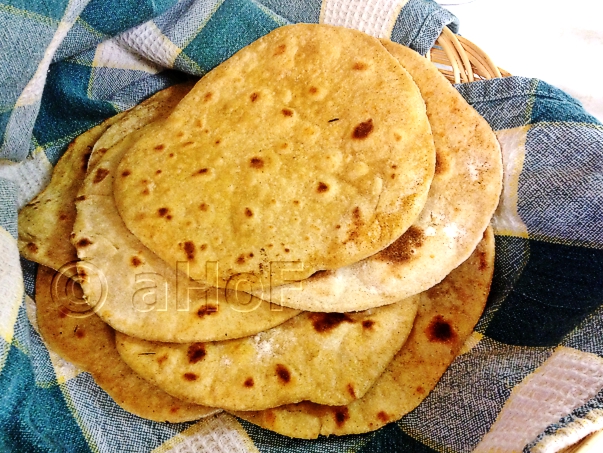 |
| Chapatis |
Kamut® Khorasan
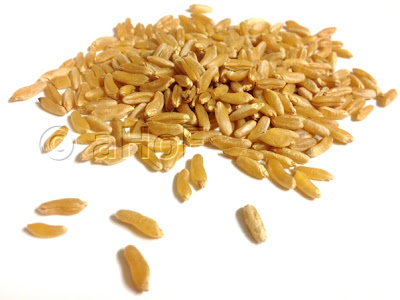
Kamut® Khorasan
Part of the reason I decided on something other than Naan Bread (apart from the fact that it is, by popular acclaim, the only bread accompaniment for Indian meals in my house), is that while on our trip, I stopped at The Whole Foods Market and found Kamut® Khorasan berries (triticum turgidum ssp. turanicum) in the bulk aisle! I have used Kamut® in past, as a flour that was a variation on regular wheat flour, and that so many are allergic to. It has been available in flour form for quite some time. Kamut® Khorasan is an ancient strain of wheat, along with another called "Emmer". These two tetraploid strains have 28 chromosomes instead of the 42 found in our hexaploid strain of durum wheat of today. Kamut® Khorasan berries are nearly twice the size of our modern wheat berries. When I bought Kamut® flour in past, I thought that Kamut® was the name of the type of wheat, but was in error. The name of this grain is actually Khorasan, referring to a historical region in modern Afghanistan and northern Iraq. The title of "Kamut®" Khorasan was given later by two brothers in Montana. Growing this strain of wheat in hopes of preserving the strain cleanly, they registered the name of Kamut.
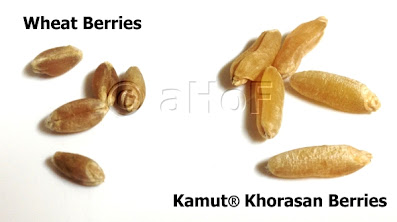 |
| Side by Side Size comparison of the grains |
Chapati recipes are all basically the same. Use a whole grain flour. Moisten it enough with water to be pliable but not wet. Knead it. Make Chapatis. The basic ratio of flour to liquid is identical everywhere I looked for comparison. The only technicality would be if you live in a very dry climate or a very humid climate, as this affects how much water will actually be needed. If you live in a humid place like Florida or Louisiana for example, your flour will already be more water saturated than if you live in Arizona. I live in neither of these places, but climate in the high plains is often dry. Add to that the heat running in the house for more than a month already, with temperatures already been dipping below zero regularly. Dry.
On to the Chapatis
As far as Indian breads go, there are quite a few types and styles. Even Naan, which is getting to be very well known, can be made as a yeast dough or may be leavened with simple baking powder. The store varieties are certainly not yeast breads, and most very closely resemble large, soft flatbreads or pitas without pockets. Chapatis are more similar to a flour tortilla, in that they are most basically a simple and unleavened, thin, flat cake, traditionally cooked on a flat griddle called a tava. At home a hot skillet works just fine. Other Indian breads are many. To name a few, there are rotis (similar to chapatis), parathas (larger, thicker, fried), puris (fried and puffed up) and papadums (crispy). Each of these is unleavened. The differences are in how they are made, thickness, size and texture. I hope to make parathas again sometime soon. I have made them in past and they turned out very well. (If any of these descriptions is in error, please pardon me. I have not a drop of Indian blood in me, but am endlessly fascinated with all things Indian). |
| Flour water & oil mixed | dough well kneaded | rested and cut in portions | dough rolled into 6 - 7-inch circles |
It is most common to make all of these breads with whole grain flour, though some are made with white flour. The recipe's ratio of flour to water is 3 parts whole grain flour to 1 part water. Some recipes call for added oil or ghee; some do not. I added a little oil to my recipe. Some recipes call for mixing the ingredients and kneading briefly to combine, while some recipes call for kneading for longer periods of time. Longer kneading yields a more elastic dough, easily rolled and shaped without tearing.
I spent some time here on the detail of using Kamut® Khorasan flour. Whole wheat flour may as easily be used. It is an option to leave the dough, once kneaded, for a minimum of an hour, and even better if it is left overnight, before proceeding to roll out the chapatis.
Chapatis
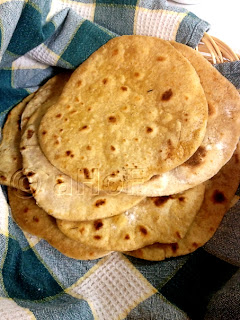
Chapatis

Makes 8 chapatis
1½ cups whole grain flour; wheat or Kamut® Khorasan
½ cup water
1 tablespoon of oil or ghee
more oil or ghee for cooking the chapatis
In a bowl, combine the flour and water, mixing to combine. Add the oil or ghee and blend in. Turn the mixture out onto a very lightly floured surface or an oiled surface. Knead the dough for at least 5 minutes; more ideally for about 9 minutes. This develops the gluten in the flour, making it easier to roll out and form the chapatis without tearing. Set the dough aside to rest, covered, for at least one hour, or longer if possible. If leaving to rest overnight, place the dough, well wrapped, in the refrigerator until ready to use.
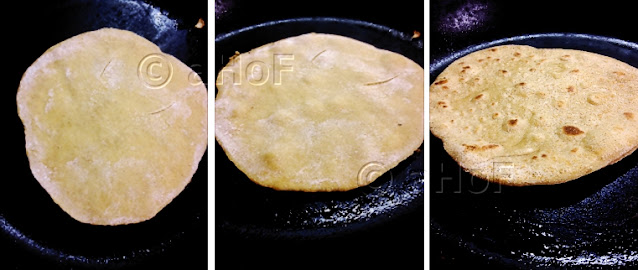 |
| dough circle just placed in hot pan | bubbles forming under the surface | flipped over and nearly done |
Cut the dough into 8 equal sized pieces. Roll each portion of dough into a smooth ball. Lightly flour a surface and roll the dough into a thin circle of about 6 or 7-inches diameter. Heat a skillet to medium heat. Add in a small amount of oil or ghee to the pan and place one of the circles of dough in the hot pan. Almost immediately it will begin to form bubbles. Turn the chapati to cook the opposite side once the first side has well browned spots, about 2 minutes. Once flipped over, the opposite side should also have nicely browned spots, about 1 minute longer. Remove to a towel lined container and continue to make each individual chapati in the same manner.
My passion is teaching people how to create a harmony of flavors with their cooking, and passing along my love and joy of food, both simple or exotic, plain or fancy. I continue my journey in ethnic and domestic cuisines, continuing my journey to explore diverse culinary experiences and hopefully to start you on a journey of your own. Join me also at A Harmony of Flavors on Facebook, and Pinterest.

Thanks for the recipe, Chris. I often put a chicken curry together and these will 'go' perfectly. I've just started into my adventure with kharosan flour as I can't eat modern wheat and my husband would like an alternative due to all the herbicide residue in modern wheat and because it makes him fat!! Let's hope this will make a difference.
ReplyDelete